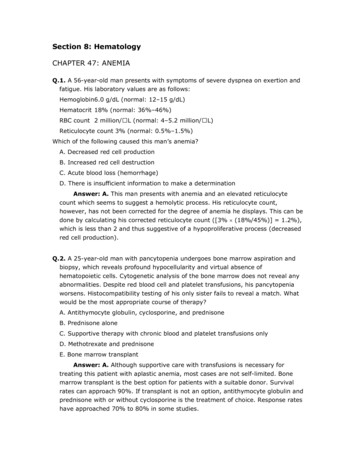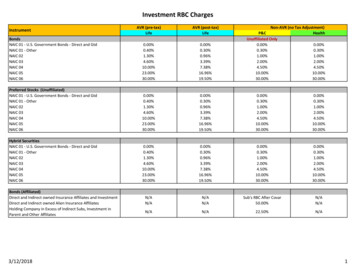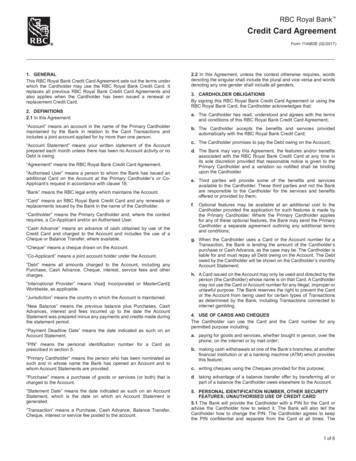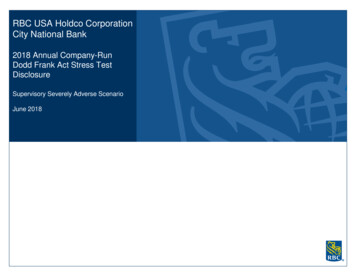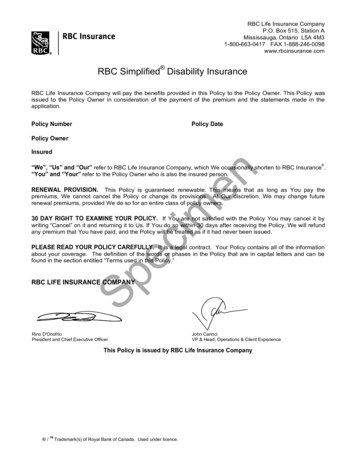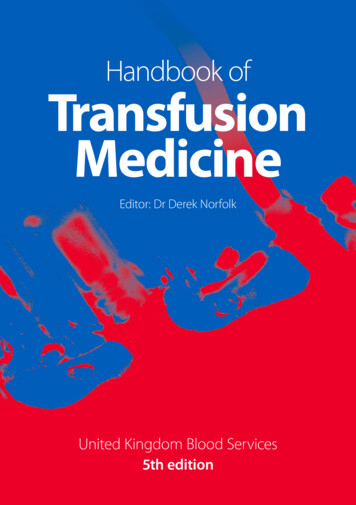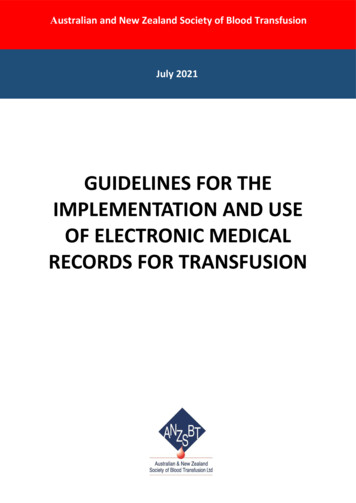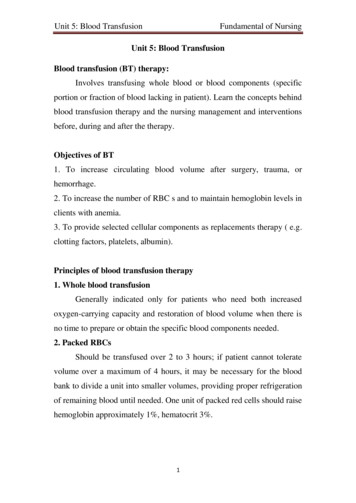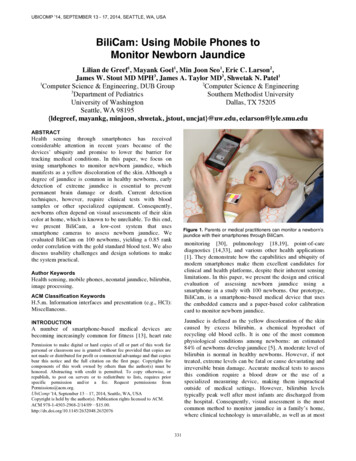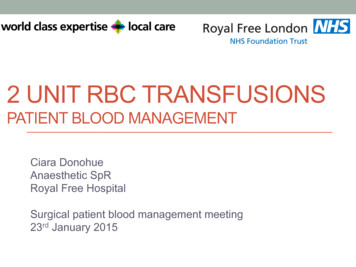
Transcription
2 UNIT RBC TRANSFUSIONSPATIENT BLOOD MANAGEMENTCiara DonohueAnaesthetic SpRRoyal Free HospitalSurgical patient blood management meeting23rd January 2015
Background Patient blood management (PBM) Rationalised use of a potentially hazardous, costly and scarce resource1 Restrictive transfusion strategies Systematic review of observational cohort studies: Increased morbidity and mortality in transfused patients (risks outweighed benefits)2 RCTs: Improved outcomes in restrictive transfusion threshold group (trigger Hb 7g/dL) (TRICC)3 Equivalent outcomes in high risk orthopaedic patients with restrictive vs liberal TXNstrategies4 Excessive transfusion is common5 25% transfusions result in post TXN Hb 9g/dL Post transfusion/discharge Hb is a surrogate marker of TXN appropriateness
Unit by unit transfusionPolicies Desirable because . Each and every unit of blood is a rationalised independent clinicaldecision (expected benefit outweighs risk) May reduce unnecessary transfusion in conjunction with restrictivetransfusion strategies Patient centred and tailored Possible because . Examples of successful implementation internationally Western Australia7,8, Maine9
Single unit transfusion
What is our 2 unit transfusion practice? Inclusion Adult inpatients 2 units of RBC during a 12 hour period (medical surgical) Exclusion Haematology Renal ICU Data Collection 15/6/14 – 14/7/14 Patients identified at blood bank Ward follow up: notes & electronic record review
Results 58 2 unit RBC transfusions identified over 1 month period DemographicsOrthoHPB Median age 69.8 years [IQ range 47.5 - 84.5]GastroVascularGeriGen surg F 60%, M 40%HepatologyBreastPlasticsGen med Surgical 65.5%, Medical 34.5%TransplantOncologyUrology Hx IHD 10% Mean pre TXN Hb 77 g/L (SD 10.2) Mean post 2 unit Hb 98 g/L (SD 11.1)02468Number of patients1012
Results 95% patients were transfused 2 units on the wardDocumentation of triggers for transfusion in notes403537302520151615109580AnaemiaEvidence of bloodlossSymptomsCV instablityNo indicationdocumented
Results – Post 2u transfusion Hb130-139.9Post transfusion Hb (g/L)120-129.9110-119.9100-109.990-99.980-89.9 80051015Number of patients202530
Patients with post TXN Hb 100g/L 20/58 (34.5%)Ortho DemographicsGeriVascular Median age 69.6 years[IQ range 48 – 85]BreastGastroMedical40%Gensurg M 53% F 47%Surgical60%GenmedHepatology Hx IHD 2/20 (10%)Urology01234 Evidence of blood loss 4/20 (20%), 1 with active clinically significantbleeding Mean pre TXN Hb 82.8 g/L (SD 12.2) Mean post 2 unit Hb 108.8 g/L (SD 8.68)5
Orthopaedic transfusion practice All major elective/emergency orthopaedic cases 2 month period (09/2014 - 10/2014) Electronic patient record trawl: Demographics Pre op Hb Post op Hb Lowest recorded Hb Number of units RBC transfused Post transfusion Hb Discharge Hb
n ion142unittransfusionSingleunittransfusion 2unittransfusion78
Impact of pre operative Hb on transfusionrates131%4%1138% ttransfusionNoTransfusion1448%PreopHb 120g/LPreopHb 120g/L
Impact of urgency of surgery ontransfusion rates11%56%11%945% cysurgery
Post transfusion Hb16141210Totalnumbers8PostTxHb 10014PostTxHb90- ‐1006PostTxHb 904207541221SingleunitTx2unitTxTransfusedpaIents(n 18)
European Transfusion Practice and Outcome Study An observational multi-centre evaluation of transfusion care andclinical outcome for elective surgical patients Objectives Describe differences in transfusion practice (and relate to perioperativeoutcomes) Inclusion Adult, elective, non cardiac Transfused at least one unit RBC in the operating theatre Sample size and centres 3 month period 11 trusts UK 30 European countries 5855 transfusions reported
UK Pre operative ions(%)70%Hbstartsurg
UK Transfusion usiontriggerHb420%210%0%0123456UKtrustsRF891011
UK Perioperative transfusion ndsurg
0Hb(g/dL)Percentageoftotalunits50%
Conclusions 2 unit transfusions are still commonly prescribed: RFH/UK/Europe Many result in final Hb 100g/L Implementing a unit by unit policy ( restrictive triggers/targets) EVERY UNIT TRANSFUSED IS AN INDEPENDENT CLINICALDECISION WHERE BENEFIT OUTWEIGHS RISK Reduction in unnecessary 2nd unit RBC Reduce RBC usage Reduce dose dependent risks of RBC transfusion
Future plans - pilot
Measuring success
Thank you
References1.2.3.4.5.6.7.8.9.Patient blood management. An evidence based approach to patient care. NationalBlood Transfusion Committee. 2014 http://www.transfusionguidelines.org.ukMarik et al. Efficacy of red blood cell transfusion in the critically ill: A systematic reviewof the literature. Critical Care Medicine 2008; 36 (9): 2667-2674Herbert et al. A multicenter randomised cotrolled clinical trial of transfusionrequirements in critical care (TRICC). NEJM 1999; 340 (6): 409-417Carson et al. Liberal or restrictive transfusion in high risk patients after hip surgery.NEJM 2008; 365 (26): 2453-2462Edwards et al. Patient blood transfusion management: discharge haemoglobin level asa surrogate marker for red blood cell utilization appropriateness. Transfusion 2012; 52:2445-2451Vuille-Lessard et al. Red blood cell transfusion practice in elective orthopaedic surgery:a multicenter cohort study. Transfusion 2010; 50: 2117-2124Leahy et al. (Western Australian PBM program) A pragmatic approach to embeddingpatient blood management in a tertiary hospital. Transfusion 2014; 54: 1133-1145Single unit transfusion guide summary. Guidance for Australian Health providers.National Blood Authority, Australia. June 2014Eastern Maine Medical Center Patient Blood Management Programme. 2007 http://www.emmc.org/blood management
a surrogate marker for red blood cell utilization appropriateness. Transfusion 2012; 52: 2445-2451 6. Vuille-Lessard et al. Red blood cell transfusion practice in elective orthopaedic surgery: a multicenter cohort study. Transfusion 2010; 50: 2117-2124 7. Leahy et al. (Western Australian PBM program) A pragmatic approach to embedding
